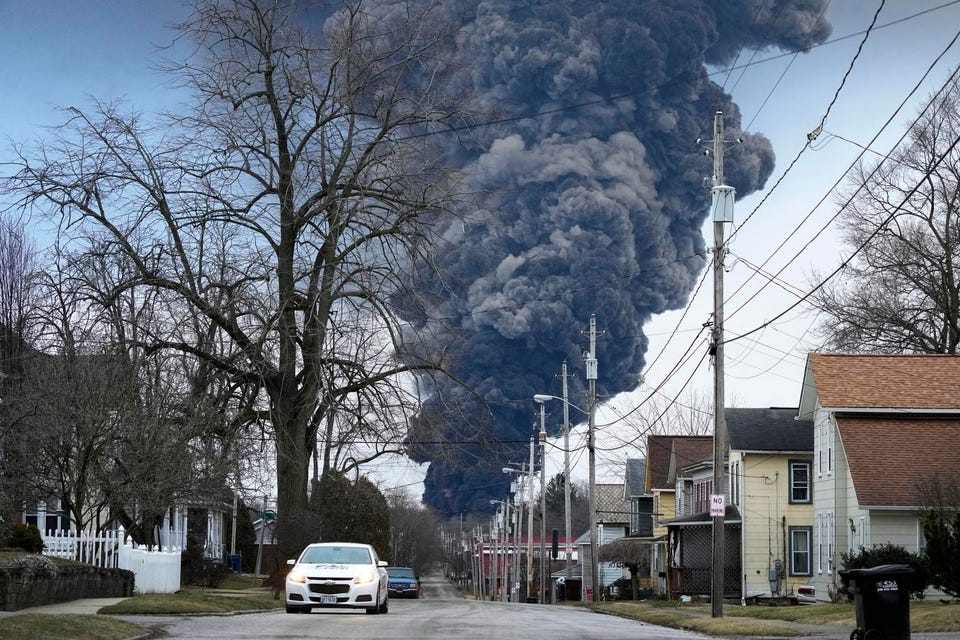Forbes Innovation Science Tracking Unidentified Balloons And Train Derailment Smoke Plumes – What Is HYSPLIT? Marshall Shepherd Senior Contributor Opinions expressed by Forbes Contributors are their own. Following Feb 18, 2023, 10:30am EST | Press play to listen to this article! Got it! Share to Facebook Share to Twitter Share to Linkedin OHIO, UNITED STATES – FEBRUARY 17: (——EDITORIAL USE ONLY â MANDATORY CREDIT – “UNITED STATES . .
. [+] ENVIRONMENTAL PROTECTION AGENCY (EPA) / HANDOUT” – NO MARKETING NO ADVERTISING CAMPAIGNS – DISTRIBUTED AS A SERVICE TO CLIENTS——) Smoke and flames rise after after the train derailment in East Palestine, Ohio, United States on February 17, 2023. The train derailment happened on Feb.
3 in which 38 cars derailed, including 11 containing hazardous materials, forcing hundreds of residents to evacuate for several days. (Photo by US Environmental Protection Agency / Handout/Anadolu Agency via Getty Images) Anadolu Agency via Getty Images In recent weeks, there has been quite a bit of abnormal activity in the skies of the United States. Unidentified balloons are penetrating our airspace, and hazardous smoke has been spewing from a horrific railroad accident in Ohio.
The National Oceanic and Atmospheric Administration (NOAA) HYSPLIT model has been used to assess both. What is it anyhow? Many of us within the atmospheric sciences community are familiar with the HYSPLIT model, but there is no reason that you should be. According to NOAA’s Air Resources Laboratory website, HYSPLIT is, “A complete system for computing simple air parcel trajectories, as well as complex transport, dispersion, chemical transformation, and deposition simulations.
” In other words, it is a model that can be used to assess atmospheric transport and dispersion. The website goes on to say, “HYSPLIT has also been used in a variety of simulations describing the atmospheric transport, dispersion, and deposition of pollutants and hazardous materials. .
. . examples of the applications include tracking and forecasting the release of radioactive material, wildfire smoke, windblown dust, pollutants from various stationary and mobile emission sources, allergens and volcanic ash.
” The model has the ability to do back or forward trajectory analyses. With this capability, we can actually trace the origin of air masses or where it is going. On February 3, 2023, a huge fire was associated with a train derailment in East Palestine, Ohio.
According to NOAA, roughly 50 cars derailed, and they were carrying hazardous materials such as vinyl chloride. Weather satellite imagery below revealed the cloud cover and the extent of the smoke associated with the fire. MORE FOR YOU Why The Rock’s Social Media Muscle Made Him Hollywood’s Highest-Paid Actor Kevin Love’s Buyout With The Cleveland Cavaliers, Explained U.
S. Accuses Russia Of Crimes Against Humanity In Ukraine—Here’s What That Means The NOAA Air Resources Laboratory posted this statement on its website – “The local Weather Forecasting Office has been using HYSPLIT runs to monitor the situation and the resulting plume rise of the vinyl chloride. ” They further noted that the vinyl chloride posed a significant threat to human health.
Understanding plume transport or dispersion was critical in this circumstance. Many of us were also able to use the HYSPLIT model to track balloons entering North American air space in recent weeks. Some people used the model to try to determine origin of the objects (back trajectories) while others used forward trajectories to assess where they might go.
The Tweet below from The Washington Post Capital Weather Gang is a good example. By the way, HYSPLIT uses a host of data from numerical weather models that provide our weather forecasts. Such data comes from the GFS, NAM, and HRRR models.
For a complete listing, this link is a good resource. For me, the irony is that our weather models rely on data from balloons to diagnose the vertical state of the atmosphere. These weather balloons are launched twice daily at a minimum with special launches during severe weather.
All balloons in the sky aren’t big, bad and scary. STERLING, VA-OCTOBER 1:Meteorologist, Carrie Suffern Prepares to Release the Weather Balloon at . .
. [+] National Weather Service Headquarters on October 1, 2012 in Sterling Virginia(Photo by Benjamin C. Tankersley/For The Washington Post via Getty Images) The Washington Post via Getty Images Follow me on Twitter .
Check out my website . Marshall Shepherd Editorial Standards Print Reprints & Permissions.
From: forbes
URL: https://www.forbes.com/sites/marshallshepherd/2023/02/18/tracking-unidentified-balloons-and–a-train-derailment-smoke-plumewhat-is-hysplit/
